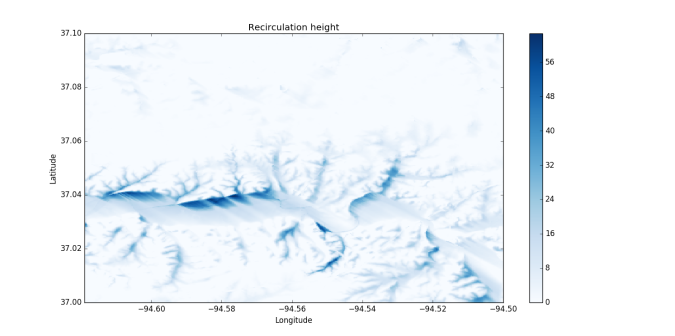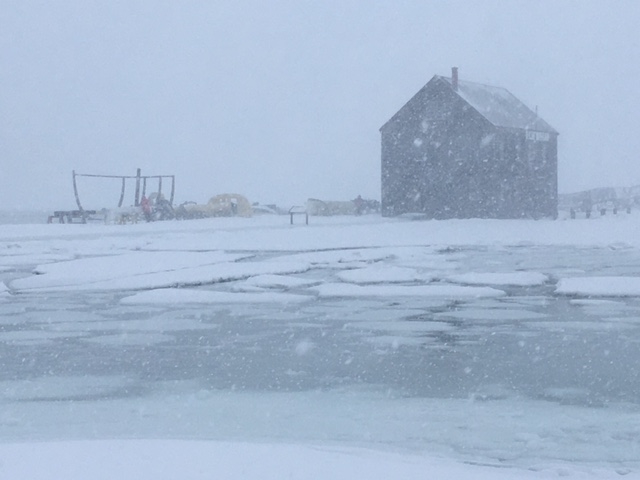For the past several months, I have been working on a model to describe windflow over varied terrain. The purpose of this model is to calculate average wind motion on a fine grid throughout the day leading up to a possible tornado event, which will later be used to map heat and moisture differences. I opted to build this model from scratch because existing windflow models (like the wonderful Global Wind Atlas) focus on regional wind climate, too long-term and broad-scale for my analysis. Also, building a program yourself provides an intimate understanding of the physics/math behind the colorful plot. That is, as long as you know where to start.
Wind is a complicated subject, turbulent and unpredictable by nature. Turbulent flow fields are often simulated using computational fluid dynamics (CFD), most commonly a large eddy simulation (LES, see footnote). But these approaches are computationally expensive – the calculations I’d like to do would take hours or days on my laptop – so I searched for reasonable ways to average out the turbulence. Despite decades of field research (other footnote), there’s still no consensus method for wind profiling over diverse terrain. So I made my best attempt to synthesize data from many studies into parameterizations suitable for the rolling-but-not-rugged terrain of the central U.S.
First, I had to understand how sustained winds and gusts behave over homogeneous terrain. For flat areas with uniform land surface, the mean winds assume a logarithmic velocity profile, with rough surfaces creating additional disturbance close to the ground. Deviations in speed and direction from the mean profile have been shown to be roughly approximated by Gaussian distributions. These assumptions are widely used as the basis for regional weather and climate models because they allow for the calculation of fluxes of momentum, heat, and moisture over wide area averages. To narrow the analysis to small features, I elected to treat terrain differences as “obstacles,” which have been thoroughly described by aerodynamics studies. Obstacles have two predominant effects on surface-level flow: blocking and channeling. Linear wind blocking was evaluated point by point for the Gaussian distribution of wind directions at the given wind direction. A mass balance was applied to these blocking wind profiles to include the effects of flow channeling. The result was a map that could identify surface eddies in seconds from inputs of average wind speed and direction, shown below:

The map represents the SW quadrant of Joplin, MO, and the blue areas identify the persistence of flow eddies in the Shoal Creek valley. In this plot, the wind was initialized to be 8 m/s from the NW (as in a typical cold front), and the scale bar indicates the height of recirculation eddies in meters. While preliminary tests have shown that this model compares well to the Global Wind Atlas’s orographic speedup feature, I am curious whether this model’s simplicity would hold up to field experiments or more complex terrain features. Either way, I am excited to implement the next step on top of this wind model: a detailed heat and moisture map of the boundary layer.
Footnote: For practical purposes, research meteorologists most often use a Large Eddy Simulation (LES) to simulate wind flows, which simplifies the Navier-Stokes Equations by lumping small turbulent motions into a ‘dissipation’ term. This approach will be essential when I want to model the physics of tornado motion, but not critical for boundary layer modeling.
Other Footnote: Potentially game-changing research is happening in this area, which could one day lead to a consensus. The NSF-funded Perdigao project, begun in Spring 2017, seeks to resolve wind fields over complex hilly-to-mountainous terrain in Portugal. This dataset should be far more comprehensive than the current standard taken in the 1980s around Scotland’s Askervein Hill.
Title Credit: Bob Dylan
 Grayson on Thursday, bearing down on the Northeast like an ice cold hurricane (GOES16-East imagery, source: NASA).
Grayson on Thursday, bearing down on the Northeast like an ice cold hurricane (GOES16-East imagery, source: NASA).